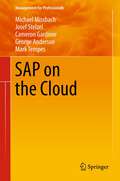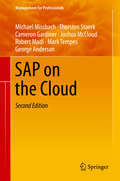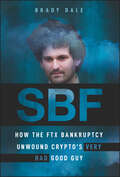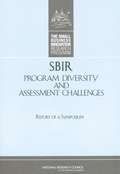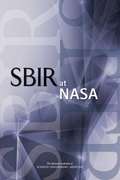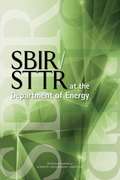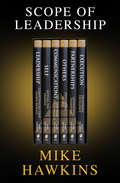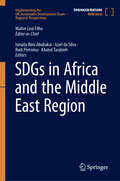- Table View
- List View
SAP SE: Autism at Work
by Robert D. Austin Gary P. PisanoThis case describes SAP's "Autism at Work" program, which integrates people with autism into the company's workforce. The company has a stated objective of making 1% of its workforce people with autism by 2020. SAP's rationale for the program is based on the belief that "neurodiversity" contributes to the company's overall innovative capabilities ("We believe that innovation comes from the edges"). Thus, the program is not viewed as a subsidized Corporate Social Responsibility activity, but as a positive net benefit activity, as well as a way of addressing skills shortages by tapping into non-traditional pools of (considerable) talent. The case explores how SAP is also using the program to rethink and re-engineer its Human Resource Management policies and processes, to make them more inclusive and effective.
SAP SE: Autism at Work
by Robert D. Austin Gary P. PisanoThis case describes SAP's "Autism at Work" program, which integrates people with autism into the company's workforce. The company has a stated objective of making 1% of its workforce people with autism by 2020. SAP's rationale for the program is based on the belief that "neurodiversity" contributes to the company's overall innovative capabilities ("We believe that innovation comes from the edges.") Thus, the program is not viewed as a subsidized Corporate Social Responsibility activity but as a positive net benefit activity, as well as a way of addressing skills shortages by tapping into non-traditional pools of (considerable) talent. The case explores how SAP is also using the program to rethink and reengineer its Human Resource Management policies and processes to make them more inclusive and effective.
SAP UI Frameworks for Enterprise Developers: A Practical Guide
by Marius Obert Volker BuzekDive into the world of SAP UIs and begin your journey to becoming a development expert. In this book, you will learn the latest cutting-edge web technologies and gain a comprehensive understanding of the user experience concept that undergirds the SAP Fiori design system. SAP UI Frameworks for Enterprise Developers is filled with hands-on tutorials that will guide you through every step of the development journey, from setting up your coding editor to building your first application using UI5, SAP Fiori Elements, UI5 Web Components, or Fundamental Library Styles. Authors Marius Obert and Volker Buzek understand that staying ahead in the rapidly evolving UI technology landscape can be challenging, so they’ve included insights into upcoming industry-wide trends and future innovations. This book will provide you with the knowledge and skills needed to build intuitive applications with an eye-catching, SAP Fiori-conforming user interface. Don’t miss this opportunity to take your UI development skills to the next level!What You Will LearnGain an overview of the technologies that can be used to implement enterprise-ready SAP Fiori UIs ready to be deployed in the cloud as well as on-premisesDiscover resources for connecting with domain experts to stay on top your game and learn about innovations in the SAP ecosystemSurvey industry-wide technologies trends, like micro frontends and PWA, and relate these trends to both enterprise software and new projects led by SAPWho This Book Is For This book is intended for anyone interested in building intuitive enterprise user interfaces with modern web technologies in the greater SAP universe.
SAP on the Cloud
by George Anderson Mark Tempes Michael Missbach Josef Stelzel Cameron GardinerThis book provides an introduction to the various facets of building and operating an SAP infrastructure exploiting Cloud technologies. It describes and discusses the latest developments and challenges and suitable solutions, and also outlines future trends where possible. To ensure that this book is also useful to readers who do not consider themselves experts in this area, this book explains in detail the backgrounds of the various solutions. Also, practice-oriented case studies are provided throughout the book in order to make the reader aware of essential but perhaps less obvious points. However, the book concentrates exclusively on the set up and operation of the SAP infrastructure. It does not give details on how to install and customize the SAP software, nor does it deal with the much more complex tasks involved in business process implementation and reengineering.
SAP on the Cloud
by George Anderson Mark Tempes Michael Missbach Cameron Gardiner Thorsten Staerk Joshua Mccloud Robert MadlThis book offers a comprehensive guide to implementing SAP and HANA on private, public and hybrid clouds. Cloud computing has transformed the way organizations run their IT infrastructures: the shift from legacy monolithic mainframes and UNIX platforms to cloud based infrastructures offering ubiquitous access to critical information, elastic provisioning and drastic cost savings has made cloud an essential part of every organization's business strategy. Cloud based services have evolved from simple file sharing, email and messaging utilities in the past, to the current situation, where their improved technical capabilities and SLAs make running mission-critical applications such as SAP possible. However, IT professionals must take due care when deploying SAP in a public, private or hybrid cloud environment. As a foundation for core business operations, SAP cloud deployments must satisfy stringent requirements concerning their performance, scale and security, while delivering measurable improvements in IT efficiency and cost savings. The 2nd edition of "SAP on the Cloud" continues the work of its successful predecessor released in 2013, providing updated guidance for deploying SAP in public, private and hybrid clouds. To do so, it discusses the technical requirements and considerations necessary for IT professionals to successfully implement SAP software in a cloud environment, including best-practice architectures for IaaS, PaaS and SaaS deployments. The section on SAP's in-memory database HANA has been significantly extended to cover Suite on HANA (SoH) and the different incarnations of HANA Enterprise Cloud (HEC) and Tailored Datacenter Integration (TDI). As cyber threats are a significant concern, it also explores appropriate security models for defending SAP cloud deployments against modern and sophisticated attacks. The reader will gain the insights needed to understand the respective benefits and drawbacks of various deployment models and how SAP on the cloud can be used to deliver IT efficiency and cost-savings in a secure and agile manner.
SAP's CEO on Being the American Head of a German Multinational
by Bill Mcdermott"Today I’m the chief executive of SAP, which is headquartered in Walldorf, Germany. The company was founded by five engineers who would build SAP into a market-leading business software maker and a crown jewel in Germany’s strong economy. I’m the first American to lead SAP in its 45-year history. I’m also the only American-born CEO leading a company on the DAX, Germany’s stock exchange. I’m the only American on the European Round Table of Industrialists, a group of CEOs of Europe’s largest companies. With a presence in nearly every country on earth, SAP has long been open to contributions by anyone, of no matter what nationality or background. Still, leading a company whose identity is rooted in a culture that’s foreign presents unique challenges—which is why few CEOs do it."
SAP: Industry Transformation
by Daniela Beyersdorfer Andrei Hagiu Pai-Ling YinSAP seeks growth in the small- and medium-sized enterprise market. To do so, it has created a platform strategy with SAP Netweaver. What are the advantages and challenges for an incumbent entering a new market? What are the benefits and challenges of implementing a platform strategy?
SAP: Industry Transformation
by Daniela Beyersdorfer Andrei Hagiu Pai-Ling YinSAP seeks growth in the small- and medium-sized enterprise market. To do so, it has created a platform strategy with SAP Netweaver. What are the advantages and challenges for an incumbent entering a new market? What are the benefits and challenges of implementing a platform strategy?
SAS For Dummies
by Chris HemedingerBecome data-savvy with the widely used data and AI software Data and analytics are essential for any business, giving insight into what's working, what can be improved, and what else needs to be done. SAS software helps you make sure you're doing data right, with a host of data management, reporting, and analysis tools. SAS For Dummies teaches you the essentials, helping you navigate this statistical software and turn information into value. In this book, learn how to gather data, create reports, and analyze results. You'll also discover how SAS machine learning and AI can help deliver decisions based on data. Even if you're brand new to data and analytics, this easy-to-follow guide will turn you into an SAS power user. Become familiar with the most popular SAS applications, including SAS 9 and SAS Viya Connect to data, organize your information, and adopt sound data security practices Get a primer on working with data sets, variables, and statistical analysis Explore and analyze data through SAS programming and rich application interfaces Create and share graphs interactive visualizations to deliver insights This is the perfect Dummies guide for new SAS users looking to improve their skills—in any industry and for any organization size.
SAS: Leadership Secrets from the Special Forces
by Jason Fox Anthony Middleton Matthew Ollerton Colin MaclachlanLife and leadership lessons from the Special Forces, from the stars of Channel 4 series SAS: Who Dares Wins - including Sunday Times bestselling author of FIRST MAN: LEADING FROM THE FRONT, Ant MiddletonAre you up to the challenge of SAS leadership? Only the best will succeed... Britain's SAS (Special Air Service) has an unparalleled reputation for soldiering excellence. Their skills and techniques have been perfected in the most demanding environments imaginable, but many of these can also be used in our everyday lives. This book takes situations all of us will experience during our lives and presents tactical lessons drawn from SAS training and battlefield experience. Its four authors - stars of the hit Channel 4 show SAS: Who Dares Wins - how their finely honed understanding of how to handle extreme challenges can be applied in any environment. Their advice on negotiation, people management, self-motivation and resilience, among other things, can transform your performance in a whole range of scenarios: from buying a house, nailing a job interview, and the experience of dealing with rejection, to maintaining a diet, or managing that pushy colleague at work.This is the ultimate guide to leadership and personal achievement.
SBF: How The FTX Bankruptcy Unwound Crypto's Very Bad Good Guy
by Brady DaleA first-hand look at the extraordinary collapse of FTX, Alameda Research, and Sam Bankman-Fried In SBF: How the FTX Bankruptcy Unwound Crypto’s Very Bad Good Guy, accomplished crypto reporter Brady Dale presents an engrossing take on the spectacular and sudden implosion of FTX, Alameda Research, and their associated companies, as well as the criminal indictments of Sam Bankman-Fried and several of his associates. In the book, you’ll go beyond the salacious details and tawdry gossip to grasp the real lessons to be learned from one of the most dramatic corporate failures in living memory. The author explores: The often-confusing world of cryptocurrency and decentralized finance, offering a deep understanding of both industries The history of Sam Bankman-Fried, what smart money players had to say about him in 2019 and 2020, and why many decentralized finance professionals considered him a “pirate” even before FTX and Alameda blew up What the aggressive lobbying campaigns waged by FTX and Sam Bankman-Fried reveal about the latter’s motives and goalsAn extraordinary account of almost unimaginable wealth, greed, and hubris, SBF is a can’t-miss account of a fascinating corporate tragedy that continues to unfold to this very day.
SBIR Program Diversity And Assessment Challenges: Report Of A Symposium
by Charles WessnerIn response to a Congressional mandate, the National Research Council conducted a review of the Small Business Innovation Research Program (SBIR) at the five federal agencies with SBIR programs with budgets in excess of $100 million (DOD, NIH, NASA, DOE, and NSF). The project was designed to answer questions of program operation and effectiveness, including the quality of the research projects being conducted under the SBIR program, the commercialization of the research, and the program's contribution to accomplishing agency missions. The first in a series to be published in response to the Congressional request, this report summarizes the presentations at a symposium convened at the beginning of the project. The report provides a comprehensive overview of the SBIR program’s operations at the five agencies responsible for 96 percent of the program’s operations.
SBIR at NASA
by Engineering Medicine National Academies of SciencesThe Small Business Innovation Research (SBIR) program is one of the largest examples of U.S. public-private partnerships, and was established in 1982 to encourage small businesses to develop new processes and products and to provide quality research in support of the U.S. government’s many missions. The U.S. Congress tasked the National Research Council with undertaking a comprehensive study of how the SBIR program has stimulated technological innovation and used small businesses to meet federal research and development needs, and with recommending further improvements to the program. In the first round of this study, an ad hoc committee prepared a series of reports from 2004 to 2009 on the SBIR program at the five agencies responsible for 96 percent of the program’s operations—including NASA. In a follow-up to the first round, NASA requested from the Academies an assessment focused on operational questions in order to identify further improvements to the program. Public-private partnerships like SBIR are particularly important since today's knowledge economy is driven in large part by the nation's capacity to innovate. One of the defining features of the U.S. economy is a high level of entrepreneurial activity. Entrepreneurs in the United States see opportunities and are willing and able to assume risk to bring new welfare-enhancing, wealth-generating technologies to the market. Yet, although discoveries in various fields present new opportunities, converting these discoveries into innovations for the market involves substantial challenges. The American capacity for innovation can be strengthened by addressing the challenges faced by entrepreneurs.
SBIR at the Department of Defense
by Technology Committee on Capitalizing on Science Innovation An Assessment Of The Small Busin Program—Phase IICreated in 1982 through the Small Business Innovation Development Act, the Small Business Innovation Research (SBIR) program remains the nation's single largest innovation program for small business. The SBIR program offers competitive awards to support the development and commercialization of innovative technologies by small private-sector businesses. At the same time, the program provides government agencies with technical and scientific solutions that address their different missions. "SBIR at the Department of Defense" considers ways that the Department of Defense SBIR program could work better in addressing the congressional objectives for the SBIR program to stimulate technological innovation, use small businesses to meet federal research and development (R & D) needs, foster and encourage the participation of socially and economically disadvantaged small businesses, and increase the private sector commercialization of innovations derived from federal R&D. An earlier report, "An Assessment of the Small Business Innovation Research Program at the Department of Defense," studied how the SBIR program has stimulated technological innovation and used small businesses to meet federal research and development needs. This report builds on the previous one, with a revised survey of SBIR companies. "SBIR at the Department of Defense" revisits some case studies from the 2009 study and develops new ones, and interviews agency managers and other stakeholders to provide a second snapshot of the program's progress toward achieving its legislative goals.
SBIR at the National Science Foundation
by Technology Committee on Capitalizing on Science Innovation An Assessment Of The Small Busin Program-Phase IIThe Small Business Innovation Research (SBIR) program is one of the largest examples of U. S. public-private partnerships, and was established in 1982 to encourage small businesses to develop new processes and products and to provide quality research in support of the U. S. government’s many missions. The U. S. Congress tasked the National Research Council with undertaking a comprehensive study of how the SBIR program has stimulated technological innovation and used small businesses to meet federal research and development needs, and with recommending further improvements to the program. In the first round of this study, an ad hoc committee prepared a series of reports from 2004 to 2009 on the SBIR program at the five agencies responsible for 96 percent of the program’s operations -- including the National Science Foundation (NSF). Building on the outcomes from the first round, this second round presents the committee’s second review of the NSF SBIR program’s operations. Public-private partnerships like SBIR are particularly important since today's knowledge economy is driven in large part by the nation's capacity to innovate. One of the defining features of the U. S. economy is a high level of entrepreneurial activity. Entrepreneurs in the United States see opportunities and are willing and able to assume risk to bring new welfare-enhancing, wealth-generating technologies to the market. Yet, although discoveries in areas such as genomics, bioinformatics, and nanotechnology present new opportunities, converting these discoveries into innovations for the market involves substantial challenges. The American capacity for innovation can be strengthened by addressing the challenges faced by entrepreneurs.
SBIR/STTR at the Department of Energy
by Engineering Medicine National Academies of SciencesThe Small Business Innovation Research (SBIR) program is one of the largest examples of U.S. public-private partnerships, and was established in 1982 to encourage small businesses to develop new processes and products and to provide quality research in support of the U.S. government’s many missions. The Small Business Technology Transfer (STTR) Program was created in 1992 by the Small Business Research and Development Enhancement Act to expand joint venture opportunities for small businesses and nonprofit research institutions by requiring small business recipients to collaborate formally with a research institution. The U.S. Congress tasked the National Research Council with undertaking a comprehensive study of how the SBIR and STTR programs have stimulated technological innovation and used small businesses to meet federal research and development needs, and with recommending further improvements to the programs. In the first round of this study, an ad hoc committee prepared a series of reports from 2004 to 2009 on the SBIR and STTR programs at the five agencies responsible for 96 percent of the programs’ operations -- including the Department of Energy (DoE). Building on the outcomes from the first round, this second round presents the committee’s second review of the DoE SBIR program’s operations. Public-private partnerships like SBIR and STTR are particularly important since today's knowledge economy is driven in large part by the nation's capacity to innovate. One of the defining features of the U.S. economy is a high level of entrepreneurial activity. Entrepreneurs in the United States see opportunities and are willing and able to assume risk to bring new welfare-enhancing, wealth-generating technologies to the market. Yet, although discoveries in areas such as genomics, bioinformatics, and nanotechnology present new opportunities, converting these discoveries into innovations for the market involves substantial challenges. The American capacity for innovation can be strengthened by addressing the challenges faced by entrepreneurs.
SCOPE of Leadership Book Series: Leadership, Self, Communications, Others, Partnerships, and Execution (SCOPE of Leadership Book Series)
by Mike HawkinsThe fully searchable digital box set that includes the six-book series: Leadership, Self, Communications, Others, Partnerships, and Execution.The SCOPE of Leadership six-book series outlines the competencies that great leaders who lead as coaches possess. Read this series to learn the principles of developing, enabling, and inspiring people through a coaching approach to leadership. Develop the capabilities that produce consistently outstanding results; be a leader people aspire to follow; leverage cross-functional collaboration; build trust, teamwork, and a spirit of community; increase employee engagement and loyalty; communicate with confidence; foster innovation and competitive advantage; attract, develop, and motivate top talent; sustain speed, quality, and operational excellence.The SCOPE of Leadership book series teaches how to achieve exceptional results by working through people. You will learn a straightforward framework to guide you in developing, enabling, exhorting, inspiring, managing, and assimilating people. Benefit from the wisdom of many years of leadership, consulting, and executive coaching experience. Discover how to develop the competencies that align consistently with great leadership. The SCOPE of Leadership digital box set is fully searchable between books and includes links to additional resources and content by the author.“The most comprehensive treatment of leadership I’ve ever seen by one author . . . full of insightful assessments, useful tools, and practical tips.” —Jim Kouzes, coauthor of The Leadership Challenge
SCORE! Educational Centers (A)
by M. Diane Burton Jeffrey L. Bradach Naomi AtkinsDescribes the start-up, strategy, organizational design, and operations of SCORE! Educational Centers, an after-school tutoring enterprise. Alan Tripp, founder and CEO, is faced with growing organizational stresses and a looming venture capital deadline. Examines Tripp's leadership, management style, and strategy. Focuses on the steps he takes to build the company into a viable organization.
SDG11, Sustainable Cities and Communities (Towards Sustainable Futures)
by Hiroshan Hettiarachchi Shyama V. RamaniThis book explores Sustainable Development Goal (SDG) 11, providing insights into viable pathways and policy designs for a transition towards sustainable, inclusive and resilient cities. The volume discusses existing scientific literature on SDG 11 and provides conceptual frameworks relating to systemic transitions, sectoral transitions and behavioural transitions for overcoming challenges related to governance and implementation. Through detailed case studies from cities and settlements, in Europe, Middle East and Asia, it showcases the dynamic processes involved in urban transformations. Drawing from these comparative analyses, the book provides robust frameworks and tools for better solutions and viable pathways to achieve SDG targets in diverse urban settings. Rich in empirical data, this book will be useful for scholars and researchers of development studies, environment studies, urban studies, urban sociology, political economy, political studies, public policy and sociology. It will also be useful for policy makers, professionals, non-governmental organisations (NGOs) and think tanks working in the area of sustainable development and urban planning.
SDGs im Mittelstand: Nachhaltigkeit in Unternehmen ganzheitlich umsetzen (SDG - Forschung, Konzepte, Lösungsansätze zur Nachhaltigkeit)
by Patricia MoockNachhaltigkeit hat in den letzten Jahren an Relevanz stark zugenommen und ist längst auch für kleine und mittelständische Unternehmen ein wichtiges Thema. Häufig kommt die Frage auf, wie Nachhaltigkeit ganzheitlich im Unternehmen umgesetzt werden kann – hier unterstützen die Sustainable Development Goals der UN (kurz: SDGs). Als globales Rahmenwerk bieten sie einen Orientierungsrahmen sowie einen ganzheitlichen Blick auf Nachhaltigkeit und leisten für Mittelständler einen wertvollen Beitrag zur strategischen Ausrichtung, zu Innovationsvorhaben, für die Umsetzung, für die interne und externe Kommunikation und für die Entwicklung einer nachhaltigen Kultur. Die Arbeit mit den SDGs bietet den Vorteil, dass nun Mittelständler ihre jahrelangen Bemühungen der lokalen Nachhaltigkeitsarbeit mit einem global anerkannten Rahmenwerk verbinden können. Dieser Praxisleitfaden unterstützt Sie dabei, Nachhaltigkeit mit den SDGs in Ihrem Unternehmen zu verankern. Zahlreiche Checklisten, Praxisbeispiele, Workshopabläufe und Tipps geben Ihnen Orientierung und helfen bei der konkreten Umsetzung.
SDGs in Africa and the Middle East Region (Implementing the UN Sustainable Development Goals – Regional Perspectives)
by Walter Leal FilhoAfrica is one of the most vulnerable regions, and one where the implementation of the SDGs is particularly urgent. Underinvestments in natural conservation are increasing the vulnerability of people across many African countries, whose well-being is endangered by deteriorating socio-economic and environmental conditions. This volume provides a contribution towards showcasing how natural resources may be more efficiently used and investments may be mobilised to augment the limited public sector funds available to achieve the SDGs.This book is part of the "100 papers to accelerate the implementation of the UN Sustainable Development Goals initiative".
SDGs in Construction Economics and Organization: The 11th Nordic Conference on Construction Economics and Organisation (CREON), May 18-20, 2022 (Springer Proceedings in Business and Economics)
by Göran Lindahl Stefan Christoffer GottliebThis book examines how research in construction economics and organization contributes to the achievement of the SDGs. Featuring selected contributions from the 11th Nordic Conference on Construction Economics and Organisation (CREON 2022) held in Copenhagen, Demark and Malmö, Sweden, the contributions of this book explore the ways in which research in construction economics and organization assists in building resilient infrastructure, fostering green innovations and contributes to sustainable economic growth. Each contribution relates to one or more individual SDG and describes how the research contributes to the understanding of construction management and economics.
SDGs in the Asia and Pacific Region (Implementing the UN Sustainable Development Goals – Regional Perspectives)
by Walter Leal Filho Ayyoob Sharifi Usha Iyer-Raniga Artie Ng Theam Foo NgThe Asia and the Pacific region is actively seeking ways to optimise the use and availability of its natural resources, which have been contributing to environmental degradation and hindering its sustainable development. This volume documents and promotes various initiatives showcasing the efforts countries in the region are making towards the implementation of the SDGs.This book is part of the "100 papers to accelerate the implementation of the UN Sustainable Development Goals initiative".
SDGs in the European Region (Implementing the UN Sustainable Development Goals – Regional Perspectives)
by Sara Moggi Elizabeth Price Maria Alzira Pimenta Dinis Alex HopeThis volume describes the thinking on sustainable development and a variety of initiatives across Europe, illustrating regional efforts to foster sustainable communities and ecological and social innovation. It contains various contributions which showcase examples of thinking, economic and social structures and in consumption and production patterns needed, to implement the SDGs.This book is part of the "100 papers to accelerate the implementation of the UN Sustainable Development Goals initiative".


